Ball Reviews
Review: Callaway X2 Hot, X2 Hot+ and Supersoft Golf Balls

Pros: The X2 Hot and X2 Hot+ provide the distance you’d expect from a distance ball, but offer a softer feel and more spin on short irons. The Supersoft is well-rounded and the softest ball in Callaway’s 2014 lineup.
Cons: While the X2 Hot and X2 Hot+ are softer than other distance balls, it still takes a lot of work to generate spin and control around the green. The Supersoft’s low compression won’t fit the profile of golfers with faster swing speeds.
Bottom Line: The X2 Hot and X2 Hot+ deliver long, accurate distance off the driver and long irons and have a surprisingly soft feel. The Supersoft is the softest Callaway ball in the lineup, and it could be one of the best non-premium balls for golfers with slower clubhead speeds.
Note: Our scoring of the Callaway X2 Hot, X2 Hot+ and Supersoft golf balls represents an average score of all three balls. For detailed scores of each ball, see the end of this review.*
Overview
Callaway’s new Speed Regime golf balls are receiving most of the company’s airtime these days. But the X2 Hot and X2 Hot+ golf balls — riding on the tail of the successful X2 Hot drivers, fairway woods, hybrids and irons — are also getting the attention of golfers looking to find a new distance ball. The Supersoft, similar to the Titleist DT Solo, is enjoying a solid following of players looking for a soft, well-rounded golf ball at a low price point.
X2 Hot and X2 Hot+
Both the X2 Hot and X2 Hot+ are three-piece golf balls with an ionomer cover designed to deliver maximum distance with lower spin to reduce hooks and slices on all shots. Similar to the Speed Regime line, each golf ball has aerodynamics designed to optimize lift and drag based on a golfers swing speed. The X2 Hot is designed for golfers with a swing speed of less than 90 mph. The X2 Hot+ is tailored for golfers who swing their driver at more than 90 mph.
X2 Hot
[wrx_buy_now oemlink=”http://www.callawaygolf.com/balls/mens/” oemtext=”Learn more from Callaway” amazonlink=”http://www.amazon.com/gp/product/B00GLL94ZE/ref=as_li_qf_sp_asin_il_tl?ie=UTF8&camp=1789&creative=9325&creativeASIN=B00GLL94ZE&linkCode=as2&tag=golfwrxcom-20&linkId=TOARXFTLVC5CVLLA”]
X2 Hot+
[wrx_buy_now oemlink=”http://www.callawaygolf.com/balls/mens/” oemtext=”Learn more from Callaway” amazonlink=”http://www.amazon.com/gp/product/B00GLL96NY/ref=as_li_qf_sp_asin_il_tl?ie=UTF8&camp=1789&creative=9325&creativeASIN=B00GLL96NY&linkCode=as2&tag=golfwrxcom-20&linkId=WBGPRE6RUIQURQMY”]
Supersoft
The Supersoft is a two-piece, insanely low compression (38) golf ball with a large core and a very soft ionomer cover. The softer compression allows the ball to deform better at impact with a driver, which leads to reduced driver spin and maximum ball speeds. The result is a golf ball that produces long, straight distance off the tee and exceptionally soft feel around the green.
The X2 Hot and X2 Hot+ are available now in both white and yellow color and come in single digit (1-4) play numbers. The MSRP is $26.99.
The Supersoft also is available now in white, yellow, and multi-color packs and comes in single digit (1-4) play numbers. The MSRP is $19.99.
[wrx_buy_now oemlink=”http://www.callawaygolf.com/balls/mens/supersoft/” oemtext=”Learn more from Callaway” amazonlink=”http://www.amazon.com/gp/product/B00NQQCDDM/ref=as_li_qf_sp_asin_il_tl?ie=UTF8&camp=1789&creative=9325&creativeASIN=B00NQQCDDM&linkCode=as2&tag=golfwrxcom-20&linkId=SULECH3E3HG762P4″]
Performance
The X2 Hot and X2 Hot+ are both distance balls optimized for different swing speeds and designed to be long and accurate. The Supersoft is more well-rounded and has a nice blend of distance and control with a really soft feel. Going into testing, my assumption was that the X2 Hot and X2 Hot+ would perform very similarly, but that the Supersoft would likely fly a little higher, spin a little more and be slightly shorter with all clubs. My playing swing speed with the driver is 107 mph, which puts me in the range better suited for the X2 Hot+. During testing, the Speed Regime SR-2 proved to be the best ball for my swing and I’ll be comparing these three balls to themselves and also the SR-2.
Like other balls I’ve reviewed, I wanted to get a true sense of performance, so I tested all three balls on a launch monitor and on the course. To get the data, I tested a 60-degree wedge, 6 iron and a driver. While I prefer testing outdoors, I needed to retrieve the balls for multiple tests and headed to Golfsmith Extreme in Smyrna, Ga., where they let me take over a private fitting bay for a few hours.
60-Degree Full Wedge Shots
Going into the wedge testing I assumed that the X2 Hot and X2 Hot+ would spin significantly less when compared with the Speed Regime tour-ball line. I was wrong. When I’m looking at a ball’s performance with the wedge, two very important areas are spin and peak height and both balls exceeded my expectations.
Both the X2 Hot and X2 Hot+ generated more spin than the SR-2 when hit with a full wedge shot. Ball speed off the X2 Hot+ was the same and 1 mph faster with the X2 Hot. Both balls reached a similar peak height with relatively similar launch angle. The carry distance with the wedge, which I want to be consistent but don’t want to necessarily maximize, was 1 yard longer with both balls when compared with the SR-2. With spin this high off a wedge, it offers golfers the unique ability to put a distance ball in play and still being able to generate stopping power into greens when hit from wedge distance.
The Supersoft held its own as well, spinning less, but with more ball speed and a higher peak height. I was flying shots an extra 2 yards, but more interestingly, my descent angle was steeper, which would make shots float down to the green and stop dead. I would see this same flight later on the course.
6 Iron Shots
Both the X2 Hot and X2 Hot+ exceeded my expectations with the wedge, but as we moved away from the green the tour-level Speed Regime balls started to separate themselves and the X2 Hot and X2 Hot+ started to perform more like true distance balls.
The X2 Hot+ was the longest ball in the group, carrying an average of 3 yards longer than all the other balls during testing. Ball speed and launch angle with the X2 Hot+, which is matched better to my swing than the X2 Hot, were the same as the SR-2. However, the ball reached a lower peak height and had significantly less spin than the SR-2. The X2 Hot, which launched higher, also had lower ball speeds, spin and descent angle. This will result in more carry distance, but the lack of spin and the lower descent angle will make it harder to stick and hold greens with longer irons.
The Supersoft launched 3-degrees higher than the SR-2 and X2 Hot+ and reached a peak height of 4 yards higher. This is significant for golfers who struggle to get the ball airborne with the long irons. A higher launch and high peak height will generally lead to a steeper descent angle making it easier to land the ball softly on the green and stick it close.
Driver Shots
When I got to the driver portion of the testing I knew it was time to see what the X2 Hot and X2 Hot+ could really do. I wasn’t disappointed, but I wasn’t blown away. While I got more distance out of these two balls than the Titleist Velocity I tested earlier this year, I expected both balls to generate more overall distance than the SR-2. They did, but only by an average of two yards. Carry distance was the same for the X2 Hot+ but 3 yards less for the X2 Hot. The X2 Hot did, however, launch 2-degrees higher. That makes it a nice option for golfers looking to get a little more height with their driver. Interestingly, I didn’t see a decrease in sidespin with either ball compared to the Speed Regime line.
The Supersoft, sadly, didn’t stand much of a chance with my swing. And it isn’t the ball’s fault. The ultra-low compression ball generally isn’t suited for faster swing speeds as the ball deforms too much, sapping energy and resulting in shorter distances. But even so, we can still take a look at the numbers. The launch angle was almost 2-degrees higher, with 255 rpm more spin but a whopping 8 mph less ball speed. The Supersoft will perform best with swings of less than 90 mph with the driver where it will help launch the ball in the air, cut down on sidespin and lead to better carry.
The X2 Hot generated substantially less spin than the Speed Regime balls, as did the X2 Hot+ and Supersoft. As I mentioned in my review of the Speed Regime balls, for golfers looking for maximum distance, the X2 Hot and X2 Hot+ should be high on the list of any distance ball to test.
On-Course Testing
I played all three balls in calm, hot conditions, but the course was slightly softer due to rain earlier in the week. It didn’t take long after putting the Supersoft in play to confirm what I was seeing on the launch monitor. With the driver, the ball was getting up in the air more and the distance was noticeably shorter. I needed to play more of a knockdown shot to keep the flight where I like to see it. For golfers who need a little help getting the ball in the air and also want to play a ball with a softer feel, the Supersoft could be a great fit.
The X2 Hot+ was the longest ball of the day for me, even longer than the SR-2, although not by much. I caught a couple really solid drives that flew nice and straight, hit the ground and kept running. Around the greens, the X2 Hot and X2 Hot+ were not as solid for my game as the other balls in the 2014 lineup, but I’m used to playing tour balls with urethane covers that offer a lot of control. While the X2 Hot and X2 Hot+ were better than other distance balls such as the 2014 Titleist Velocity, approach shots, especially with long irons rolled out more. I also had to play for the balls to release instead of firing pitches all the way to the hole. Most golfers playing a distance ball will notice better feel around the greens and likely will not notice any less control than they are already used to.
Half Wedge Shots
Just as I did for the wedge test of the Speed Regime golf balls, I had a chance to test these three balls on the back nine of Bentwater Golf Club in Acworth, Ga.
Both the X2 Hot and X2 Hot+ reacted to half wedge shots about as I had expected, albeit with a little additional spin than I initially anticipated or saw on the course. Low spinning wedge shots bounced, checked a little and rolled out a few feet, but they weren’t getting too far away from me. The higher shots landed with a bit more softness than I expected. For a distance ball, I was impressed with the short game control these balls exhibited.
The Supersoft was a bit more versatile with a little more spin. The softer cover grabbed the green with slightly more grip and after checking up, didn’t have the rollout of the X2 Hot or X2 Hot+. The Supersoft naturally flew a bit higher, even when flighted lower, which is a great thing for most golfers. The higher flight will help the ball land softer and stick closer to the pin. The feel off the wedge, just like you’ll see later in this review, was exceptional.
Around the Green
Similar to other distance balls, or golf balls without urethane covers in general, I went into the test assuming I’d need to generate a lot of speed and catch the X2 Hot and X2 Hot+ balls cleanly to generate any kind of spin from close to the green. I was able to get some decent check, but only if I had a lot of green to work with. These balls are meant to be played on the ground and run out. I don’t think that is a bad thing at all and both balls did not perform any worse than other distance balls in their category. That said, the fact that they generate a substantial amount of spin on full wedge shots gives them a slight edge.
With the Supersoft, I was able to get some nice check on the ball, even without a ton of green to work with. The softer cover has some nice stickiness to it that allowed me to play more aggressive spinning shots. The feel off the face also contributed to a really positive impression of this ball around the greens.
Putting
Let’s talk about the Supersoft first. It’s crazy soft off the putter. Without question, I could instantly tell it was the softest of the 2014 Callaway lineup and I really enjoyed rolling putts with this ball.
All three balls rolled straight and true. With the X2 Hot and X2 Hot+, the ball seemed to jump off the face more than putts with the Supersoft or even Speed Regime balls, but similarly to other distance balls. While the feel on off-center putts felt more like I expected a distance ball should feel, putts off the center were surprisingly soft.
Looks and Feel
For distance balls, the X2 Hot and X2 Hot+ are some of the softest feeling balls in the category. Of course feel is subjective, but with every club from driver to putter, I was really surprised that these balls didn’t have the traditionally hard feel of a distance ball. There was some give off the face and flush shots felt really nice. With the Supersoft, the feeling was even softer, especially off the putter. I would suggest hitting a variety of shots with each of these balls so you can be the judge.
As is usually the case with Ionomer covers versus urethane, the white of each of these balls is a bit more stark than the slightly off-white look of the SpeedRegime line. The logos are a little less crisp and the graphics and alignment marks are a little less pronounced. But that is to be expected, and these balls have a nice look that continues to be recognizable as a Callaway.
I’ve really grown fond of yellow these days and its hard not to compare all yellow golf balls to the sexy, pearlized yellow shimmer of the Titleist NXT Tour. The Supersoft, X2 Hot and X2 Hot+ have a flatter, more muted yellow that doesn’t seem to stand out as much as the Titleist NXT Tour, but it still provides a solid yellow option for golfers who prefer to ditch the standard white.
Durability
Just like the Speed Regime testing, I attempted to complete all my testing, both on the launch monitor and on the course, using only three of each type of ball. After the testing was complete, each sleeve of X2 Hot, X2 Hot+ and Supersoft basically looked brand new with the exception of some small marks. I could wash these balls off, stick them back in their sleeve and put them in play again.
The Supersoft shows the tiniest bit of additional wear, but there are no cuts or major scratches on the cover of any of the balls I used for testing. If you can keep these guys out of the hazards, you can play multiple rounds with the same ball.
Bottom Line
The Supersoft is a well-rounded golf ball that is an excellent choice for golfers looking for a higher launch and flight, solid spin around the greens, soft feel and entry-level price-point.
If distance is what you’re after, the X2 Hot, for swing speeds less than 90 mph, and the X2 Hot+, designed for swing speeds greater than 90 mph, are some of the longest distance balls on the market. While neither ball will generate a crazy amount of spin around the greens, both pack a lot of spin on full wedge shots, and have the added bonus of a softer feel not usually found in a distance ball.
*X2 Hot and X2 Hot+
Driver Performance: 4.5 stars
6 Iron Performance: 4.3 stars
Wedge Performance: 3.8 stars
Looks and Feel: 4.2 stars
Durability: 4.6 stars
*Supersoft
Driver Performance: 4 stars
6 Iron Performance: 4.2 stars
Wedge Performance: 4 stars
Looks and Feel: 4.5 stars
Durability: 4.4 stars
- LIKE93
- LEGIT12
- WOW26
- LOL2
- IDHT0
- FLOP2
- OB1
- SHANK2
Ball Reviews
Is the Future of Golf Balls Lower Spin?
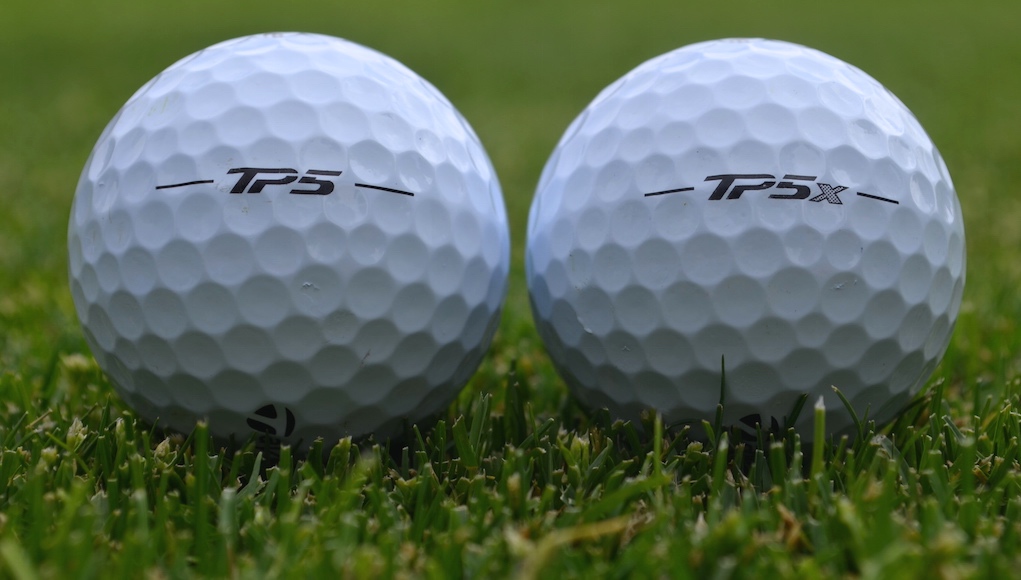
For years now, TaylorMade has been preaching lower spin to create more distance, especially in its drivers. Its original SLDR driver was actually so low spinning that TaylorMade encouraged golfers to try higher-lofted club heads, or to “loft up,” so golf balls wouldn’t dive out of the air. Now, when you look around at the popular drivers in the industry, most of them are designed to lower spin. TaylorMade was ahead of the curve.
With its new TP5 and TP5x golf balls, TaylorMade is pushing a similar initiative: lower spin on all full shots.
“This ball is different. You can make the argument this is too hot a golf ball for people who don’t spin it (enough). But that’s not the large percentage of golfers.”
For driver shots, it’s easy to understand the benefit of lower spin as long as the golfer launches it high enough. Low spin plus high launch equals more distance; that’s just a math equation. But with golf balls, as opposed to drivers, their jobs are also to get close to the hole, not just go as far and straight possible. With that in mind, is lower spin necessarily beneficial on ALL full shots, including the irons?
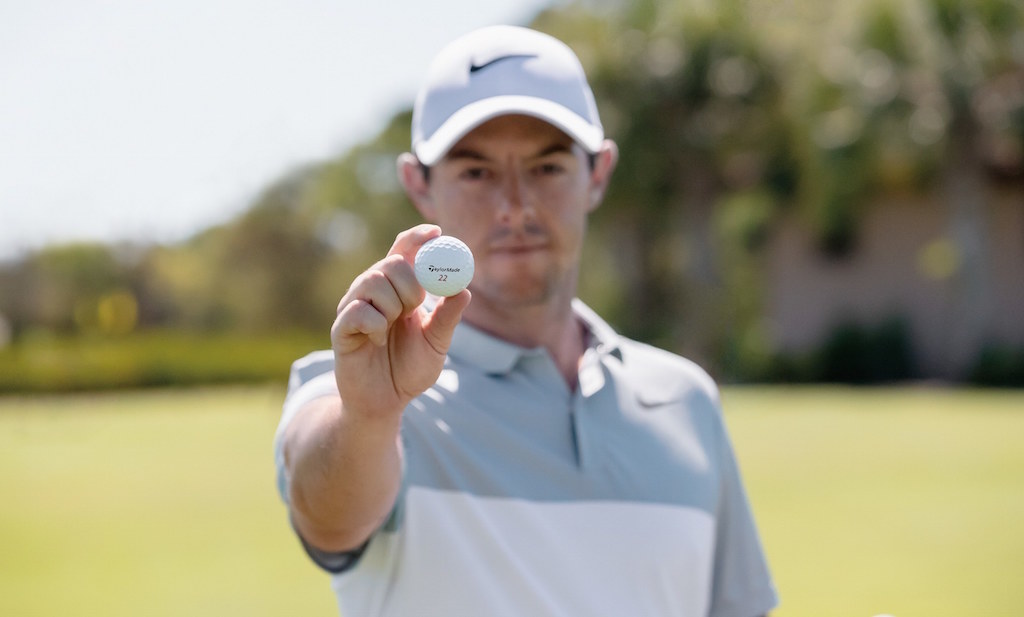
For Jon Rahm and Rory McIlroy, who both switched to TaylorMade TP5x golf ball this season — the lower-spinning and slightly firmer-feeling golf ball in the TP5 line — the answer is clearly “yes.” Rahm saw an 800 rpm drop in iron spin with a 4-iron compared to his Titleist’s Pro V1x golf ball and a 400 rpm drop in driver spin, according to TaylorMade. McIlroy saw up to 10 yards in extra distance with a 5-iron, and he picked up distance with the driver, as well. According to Eric Loper, Director of Golf Ball R&D at TaylorMade, McIlroy was hitting his 7 iron at 16.1 degrees of launch with 6350 rpm, and his 4 iron at 11.1 degrees of launch with 3800 rpm during his initial Trackman testing at The Bear’s Club.
“(With a 7 iron) you have to hit it about 7000 (rpm) or less, and he was hitting (his previous ball) up to 7500 (rpm),” Loper said. “That’s too high… (With the TaylorMade TP5x) he didn’t express any concern with (spin being too low). It was launching high, getting to its apex and landing soft.”
Hoyt McGarity, President of True Spec Golf, an internationally renowned custom club fitter with more than a dozen locations, has seen similar performance gains with TaylorMade’s TP5x golf ball through his personal testing and his testing with Tour players. He said he’s seeing 2-3 mph more ball speed compared to other golf balls. Just as importantly, he’s seeing those gains with a higher ball flight in what he called “straight up” club tests.
“Some of the Tour players — straight up, same loft, same lie, same golf club, same everything — they would launch this golf ball almost a degree higher, which is amazing,” McGarity said. “I was seeing almost 2-3 mph more ball speed for these Tour players, not that they need more distance, but I’m like, ‘You’re launching higher and it’s going further and it’s still coming in soft; it’s not coming in low and hot. It’s coming in high and still soft, so what’s the disadvantage?’ If you’re a low-ball hitter with low spin, you might have some issues. Your half shots might be tough to control the distance on it, that’s all.”
So while TaylorMade’s TP5 and TP5x golf balls are designed to go farther and with less spin on full shots, the company says their steeper landing angles will help them stop nearly as fast as higher-spinning balls. TaylorMade’s belief is based on the company’s scientific bounce-and-roll calculations, which factor in green conditions and landing characteristics. Yes, the lower spin of its golf balls in relation to competitors leads to minimally more roll out, but the amount is insignificant according to TaylorMade: an additional 1-1.5 feet. The company also points out that with a longer-flying golf ball, golfers will be hitting shorter clubs into greens, leading to more control. An 8 iron will yield greater stopping power and accuracy than a 7 iron, right?
Expert fitter Scott Felix of Felix Clubworks agrees with TaylorMade in theory. He said that as long as the golf ball is coming into a green at a steep enough angle, low spin is not a problem for approach shots.
“Most golfers spin the ball too much with their irons, costing them distance,” Felix said, “…but for golfers who already have a flat trajectory (with their irons), lowering spin won’t help them hold the green.”
McGarity added that about 80 percent of golfers who come to him for a fitting spin the ball too much, and for Tour players, the drop in spin won’t have a detrimental effect.
“Lets say the average spin on Tour is 6,000 (rpm with a 6 iron); it’s not like [TaylorMade’s TP5x golf ball is spinning] around 4,000 (rpm),” McGarity said. “If your average land angle is 49 degrees, they’re hitting these balls at say 5800 spin, which I think is great, and with a 50-degree land angle, so what’s the harm? It’s not like it’s coming in at 44 degrees; that’d be probably a one hop over the back and get into a little trouble.”
On the other hand, Felix notes that some Tour players simply want maximum control from a golf ball due to firmer fairway and green conditions, so lowering spin isn’t always the best option for them. But for average golfers, the distance gains will be beneficial.
“Most golfers aren’t playing in Tour conditions and will simply benefit from hitting the ball farther and having shorter irons into the green,” Felix said.
McGarity also warns golfers who already play low-spinning irons and drivers, and who spin the ball below 2,000 rpm with the driver, that the TP5 and TP5x golf balls may not be for them.
“This ball is different,” McGarity said. “You can make the argument this is too hot a golf ball for people who don’t spin it (enough). But that’s not that large percentage of golfers.”
After announcing an equipment contract with TaylorMade at The Players Championship, Rory McIlroy called TaylorMade’s TP5x golf ball the most important factor in his decision to sign with the company. With the new ball, he said he not only picked up distance, but consistency and control in the wind.
“I wasn’t really happy with the golf ball I was playing, and I needed to do something,” McIlroy said. “I felt like I struggled in the wind. So I sort of went back to the drawing board and tested for about 10 days pretty extensively after Augusta … I worked with the TaylorMade guys one day and started just on Trackman on the range and saw stuff with the golf ball … I thought, ‘Wow, this is what I need.’ This is exactly the thing that I’ve been struggling with.”
McGarity’s experiences confirmed McIlroy’s sentiments.
“I picked up a half club and I sit around and hit balls all the time on Trackman, so for me to pick up a half a club, it’s not the club it has to be the ball,” McGarity said. “And into the wind I can definitely see it’s more penetrating. I’m not a super high-spin player, so some shots I’ll hit the ball farther than I expected, but I’d rather have that issue than (to hit it) short.”
So there’s agreement that the ball spins less, goes farther and performs better in the wind with irons. But when fitting a golf ball, is iron play even the best place to start? Golf is about more than just iron shots, after all.
For Felix, a ball fitting begins by having a client hit “a bunch” of different golf balls on the putting green to narrow it down to a few based on feel preferences. Then he has the golfer take those golf balls to the chipping green and bunker. He then works back to 40-yard shots, narrowing down the options throughout the process based on feel and performance. After that, golfers will progress to the driver, and then to the irons.
“Usually you want to get a few balls you really like on and around the greens, then work backwards from there,” Felix said.
Initial testing for McIlroy started on the golf course, and not on Trackman, according to TaylorMade representatives. Once he became comfortable with performance and feel, he then took to Trackman to get dialed in with spin and match the golf ball to his equipment.
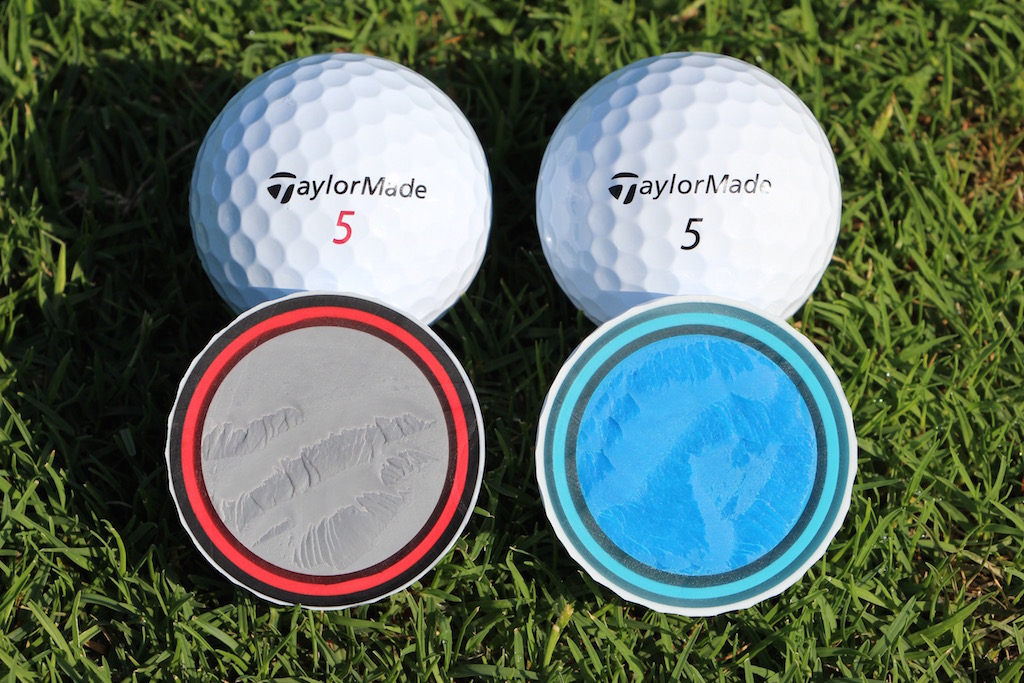
TaylorMade’s TP5x and TP5 golf ball (right), which has a slightly firmer feel.
Despite the low-spinning qualities of the golf balls on full shots, TaylorMade believes it’s giving up nothing to the competition in terms of short game performance. “There’s no golf ball that spins more around the greens,” a TaylorMade representative told me. That’s a legal way of saying no other golf ball company can prove, with confidence, that its golf ball spins more around the greens.
By producing extremely low spin on full shots, but without giving up performance and feel around the greens, TaylorMade says it’s providing the best qualities from each end of the spectrum with its TP5 and TP5x golf balls. But… how? TaylorMade engineers accomplished the feat by using larger and softer-compression cores. TaylorMade says the cores “activate” at 70 mph of swing speed inside of the five-piece constructions, which also have firm mantle layers and soft, urethane covers. The result is low spin on full shots, and high spin on shorter shots.
“It’s the real first golf ball (TaylorMade has) made that’s a game changer,” McGarity said.
TaylorMade does admit, however, that golfers may be sacrificing a bit of “workability” with the irons. That’s to say hitting hooks and slices with its golf balls becomes more difficult due to the lower spin. While the TP5 will offer a bit more of that control than the TP5x, it’s definitely something to keep in mind for those who prefer to play a Bubba Watson-style of golf.
Looking to the future
So does all of this mean that lower-spinning golf balls on full shots are the future of golf? Will we see golf equipment companies striving for drastically lower spin over the next few years?
TaylorMade representatives say they continue to chase lower spin in their prototyping, and until the golf ball is diving out of the air to the golfer’s detriment, lower spin is the future of golf balls. Obviously, TaylorMade is fully committed to a lower-spinning golf ball, and lower spin in general throughout its product lines.
For other premium golf ball manufacturers, bringing lower-spinning options to the market seems likely, given the performance benefits and Tour validation of TaylorMade’s new golf balls. But there’s a reason there are so many variations of golf balls on the market; every golfer is different. Some need more spin with the driver and want more workability with the irons, some want a super firm feel and others just want the cheapest ball possible.
Golfers should view TaylorMade’s TP5 and TP5x golf balls as options in the vast marketplace of golf balls, and perform thorough testing to figure out if this is the right line of golf balls for their game. And remember, lower spin and more distance will require recalibrating your iron distances, and possibly adjusting your equipment, so a mid-season switch is recommended only to those who are willing to put in the necessary work.
- LIKE311
- LEGIT52
- WOW18
- LOL8
- IDHT2
- FLOP6
- OB2
- SHANK79
Ball Reviews
Review: Callaway Chrome Soft X Golf Balls
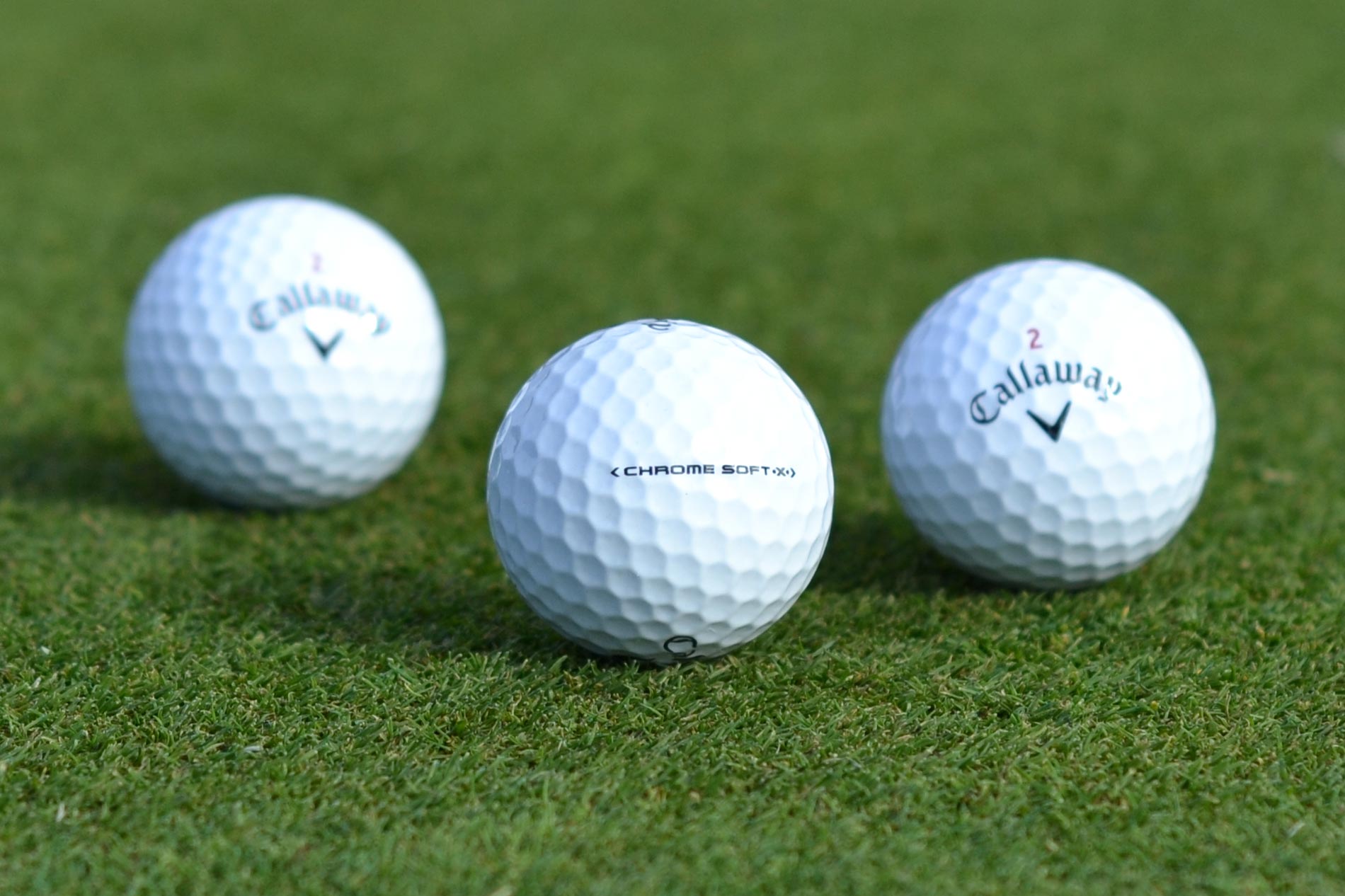
Pros: Incredibly soft feel like the Chrome Soft, but the Chrome Soft X increases spin through the bag to give better players more control.
Cons: Golfers who struggle with too much slice or hook won’t find it any easier to keep shots close to the target with the Chrome Soft X.
Who They’re For: Better players with higher swing speeds looking for a soft-feeling ball that checks up faster with iron shots than Chrome Soft.
The Review
Callaway says the Chrome Soft is “the ball that changed the ball,” and in many ways that’s true. It’s a tour-level golf ball with a softer feel, less spin through the bag and even a lower price point ($39.99) than some other tour balls in its category.
The Chrome Soft is Callaway’s best ball option for the vast majority of golfers (and received a 5-star rating by GolfWRX), but it isn’t for everyone. Callaway’s solution for them is its new Chrome Soft X golf ball.
What’s New in the Chrome Soft X
The original Chrome Soft golf ball, launched in 2015 had the very soft compression of 65. When Callaway released the 2016 version of Chrome Soft, it gave the ball a slightly higher compression (75), which improved its consistency on short-iron shots. The compression of its new Chrome Soft X is 90.
The reason for the higher compression has to do with the low-spin profile of the Chrome Soft, a blessing to most golfers as it helps their shots fly straighter and farther. It’s not ideal for some tour pros and better golfers, however. We’re talking about the kind of golfers who have great mechanics and strike shots consistently on the center of the club face. They often have a ball flight that is so dialed in that the lower-spinning performance of the Chrome Soft makes their shots harder to control. To address that small but important segment of the golfing population, Callaway created the higher-spinning Chrome Soft X.
Under the hood, Callaway used a slightly thinner urethane cover, increased the size and hardened the compression of the Dual SoftFast core, and enhanced the HEX Aerodynamics. As a result, the Chrome Soft X should generate more ball speed and spin through the entire bag.
Dave Bartels, Callaway’s Senior Director of Golf Ball R&D, says golfers will be able will notice the differences and have a clear favorite. “We expect that golfers who like the Chrome Soft X probably won’t like the Chrome Soft very much, and vice versa.”
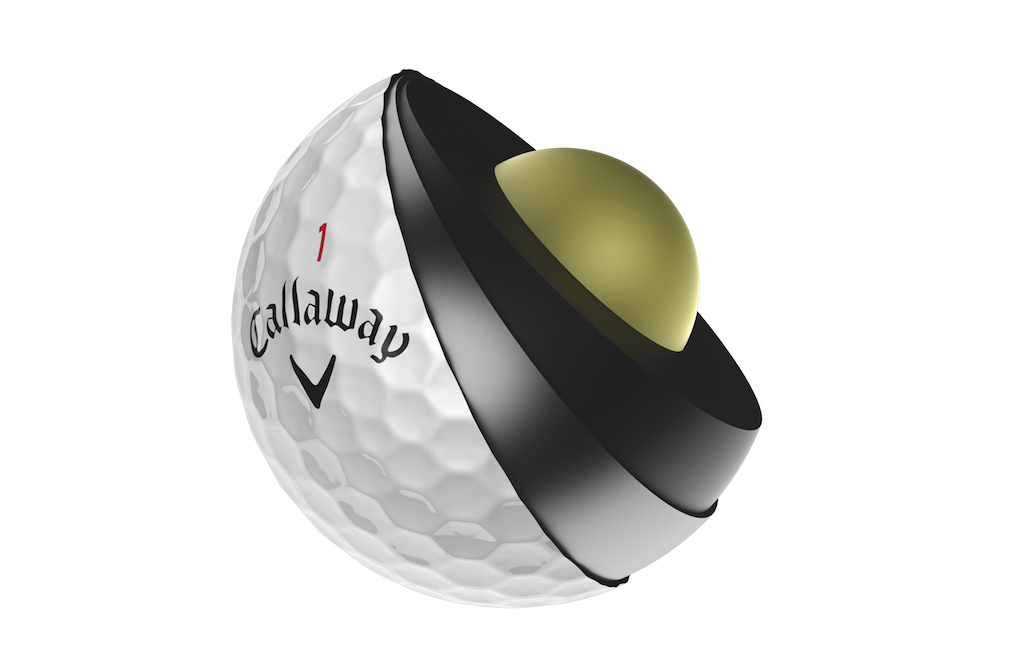 The Chrome Soft X ($39.99) will be in stores February 3 in White and Yellow.
The Chrome Soft X ($39.99) will be in stores February 3 in White and Yellow.
Performance
Since the Chrome Soft X is meant to be a complimentary golf ball to the Chrome Soft, we tested them head-to-head.
Compared to the Chrome Soft the Chrome Soft X should:
- Feel almost as soft as the Chrome Soft with the same durability.
- Generate more spin where better golfers need it.
- Generate faster ball speeds.
Like previous reviews, I tested these on the course and on a launch monitor with a 60-degree wedge, 6-iron and a driver. To allow me to re-hit each ball numerous times, I completed the testing indoors on a camera-based SkyTrak launch monitor. To keep the numbers as consistent as possible between the balls, I threw out and re-hit any shots that were not struck on the center and did not land within a designated target zone for each club (Wedge: +/- 3yards, 6 Iron: +/- 8 yards, Driver: Target width of 40 yards).
But I’m not a robot, so take that into account.
60-degree full wedge shots
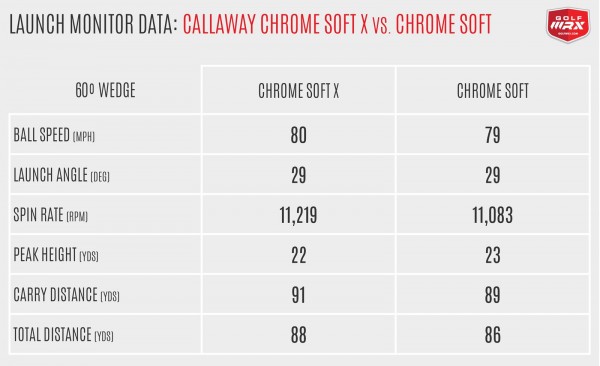 Main differences we expect to see: Not many. If anything, the Chrome Soft X might generate slightly higher ball speeds.
Main differences we expect to see: Not many. If anything, the Chrome Soft X might generate slightly higher ball speeds.
What the data actually shows: Pretty much as expected. Overall, the Chrome Soft X clocked 1 mph more ball speed, 136 rpm more spin and carried 2 yards farther. These are very subtle differences, and for an amateur like me I would not expect to notice a difference on the course.
The larger Dual SoftFast core and higher compression could account for the additional ball speed and carry distance. For me, 2 yards won’t require much of an adjustment. If you are a better player completely dialed in with your distances, you might need to make a minor adjustment.
What I saw on the course: When I’m testing golf balls, I like to drop one down without looking at the label and hit a shot. This allows me to remain unbiased in my expectation and just watch what the ball does. When I did this test with the Chrome Soft X on a full wedge shot, I was instantly impressed. The feel was incredible and the distance was spot on. After the wedge testing, I would’ve put this ball straight in the bag.
6-iron shots
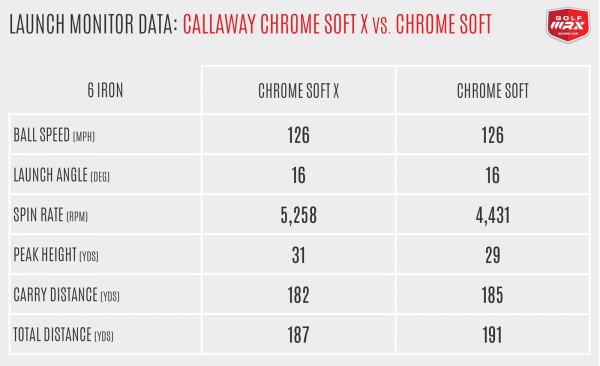 Main differences we expect to see: The Chrome Soft X should generate faster ball speeds and more spin than the Chrome Soft.
Main differences we expect to see: The Chrome Soft X should generate faster ball speeds and more spin than the Chrome Soft.
What the data actually shows: The Chrome Soft X is continuing to spin more through the bag. Ball speeds were slightly higher by about 0.8 mph. The Chrome Soft X generated a considerable amount of additional spin, but also flew slightly higher and had a steeper descent angle.
Just like you’ll see with the driver below, the additional spin decreased my distance (the Chrome Soft X averaged 3 yards less carry and 4 yards less total distance), but increased my stopping power.
What I saw on the course: Just like previous Chrome Soft balls, the feel off the club face with mid irons was very soft. I really noticed the additional spin on the course, as my draw shot shape started to get a little more curve to it and my shots stopped faster on the greens. I felt like I was able to attack greens with longer irons, flying shots all the way to the hole instead of playing a little short and letting the ball release more.
Driver shots
Main differences we expect to see: The Chrome Soft X should spin more slightly more and deliver higher ball speeds than the Chrome Soft.
What the data actually shows: I am not a high swing-speed player. My average playing swing speed is around 105 mph, which is generally considered the cut-off before you have a “high swing speed.” Also, I am not a low-spin player, so having a ball that can spin a little more might not be the best for my specific game. Based solely on that, I would not expect to see the full benefits of the Chrome Soft X
The testing backs this up. The Chrome Soft X delivered the same ball speed, but with 432 rpm more spin. Bartels says Callaway’s testing has shown golfers either spinning the Chrome Soft and Chrome Soft X the same off the tee, or an increase of 100-200 rpm with the Chrome Soft X. He called 400 rpm “within the ballpark,” but not typical.
Just to be clear, we’re talking about a change in performance that resulted in just 1 yard less carry distance and 3 yards less total distance; basically nothing.
What I saw on the course: As my launch monitor data showed, the Chrome Soft X appeared to fly higher and not roll as much when it hit the ground.
The one place I saw a benefit to the Chrome Soft X was when I contacted a drive high off the club face. With the Chrome Soft, these drives fell out of the sky more quickly, costing me carry distance. With the Chrome Soft X, they stayed in the air a little longer. It’s clear for low-spin players, or those with already optimal launch conditions, the Chrome Soft X can provide as good, if not better performance.
Around the Green
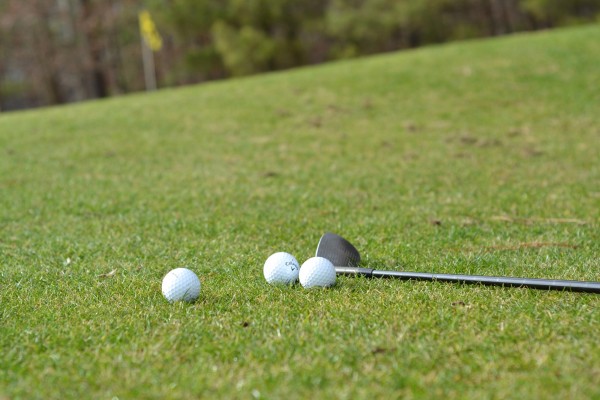 There is nothing this ball can’t do around the greens. I don’t have a tour pro’s arsenal of short game shots, but I do know the difference between a ball that can do anything and a ball that can do only some things.
There is nothing this ball can’t do around the greens. I don’t have a tour pro’s arsenal of short game shots, but I do know the difference between a ball that can do anything and a ball that can do only some things.
I put the Chrome Soft X through the paces of low spinners, high flop shots, bump and runs, and bunker shots. As expected, it performed identically to the Chrome Soft.
Putting
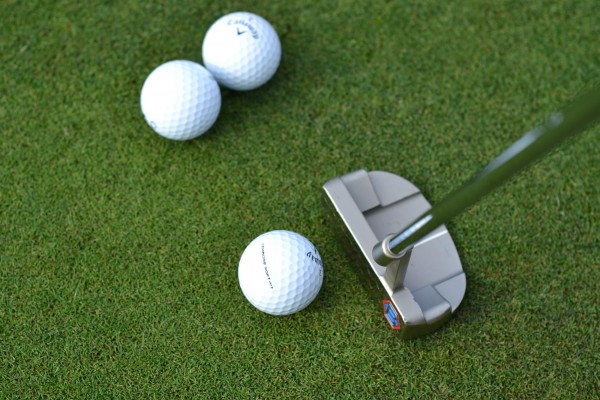 Putting one right after the other, if you are really paying attention, the Chrome Soft X feels slightly firmer off the putter face with a slightly higher-pitched sound than the Chrome Soft. But this ball is soft, smooth and rolls beautifully. I have always loved the way the Chrome Soft feels off the putter, going back to the 2015 ball. Even though it’s slightly firmer, the feel off the putter of the new Chrome Soft X continues to impress me (through the entire bag really).
Putting one right after the other, if you are really paying attention, the Chrome Soft X feels slightly firmer off the putter face with a slightly higher-pitched sound than the Chrome Soft. But this ball is soft, smooth and rolls beautifully. I have always loved the way the Chrome Soft feels off the putter, going back to the 2015 ball. Even though it’s slightly firmer, the feel off the putter of the new Chrome Soft X continues to impress me (through the entire bag really).
Feel is subjective, but I found the Chrome Soft X to be one of the softest tour balls on the market today.
Durability
I completed all my testing with only one ball, so it saw a considerable amount of shots. Like previous Chrome Soft balls, the Chrome Soft X is very durable. It took a beating with the 60-degree and showed only light scuff marks. Both the Chrome Soft X and the Chrome Soft perform very similarly in terms of durability.
The Takeaway
The Chrome Soft X isn’t for everyone and that is why Callaway is marketing the “X” as a complimentary ball to the Chrome Soft and not a replacement.
With the changes Callaway has made, the Chrome Soft X checks off all the criteria for a high-performance premium golf ball. If you thought the 2016 Chrome Soft was a little too soft with too little spin through the bag, the Callaway Chrome Soft X might just be the ball you’re looking for.
- LIKE295
- LEGIT43
- WOW14
- LOL8
- IDHT4
- FLOP8
- OB3
- SHANK25
Ball Reviews
Review: Callaway Chrome Soft golf balls
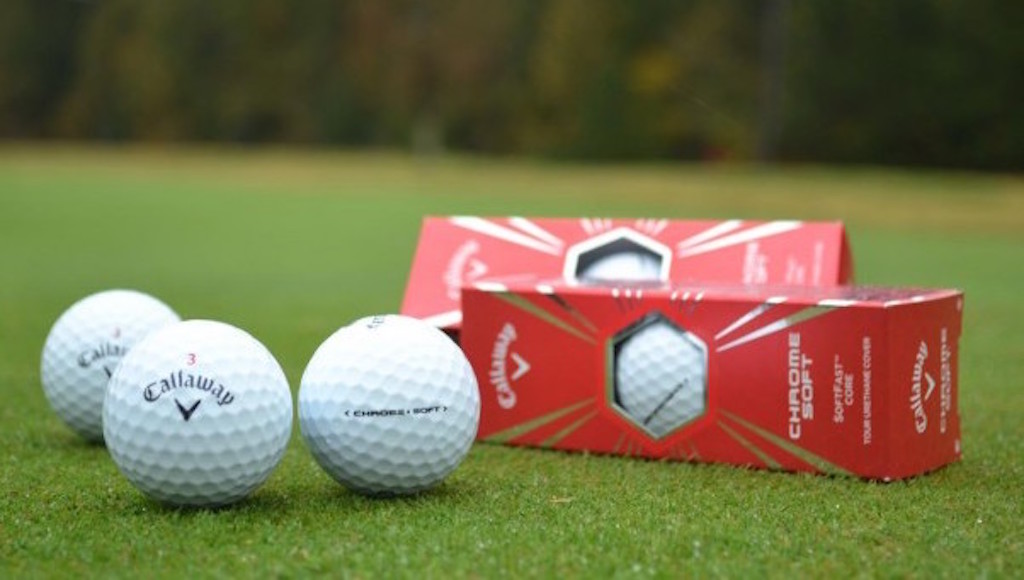
Pros: The Chrome Soft has an incredibly soft feel, but doesn’t skimp on performance. It will create maximum distance off the tee for 99 percent of golfers, yet offers short-game spin that rivals more expensive models.
Cons: Golfers with high swing speeds (105+ mph) — a.k.a. the 1 percent — may lose a few yards off the tee due to the Chrome Soft’s low-compression design.
Who They’re For: Any golfer can play the Chrome Soft.
The Review
Last year, Callaway released the Speed Regime golf ball line, which offered three different golf balls designed for different swing speeds, all with slightly different levels of compression and design. While this gave golfers the ability to really “fit” a golf ball to their game, more choices doesn’t always translate into better decision-making.
With its new Chrome Soft golf balls, Callaway has released just one ball, with one set of specifications, designed to provide a benefit to all golfers regardless of their swing speed.
The three-piece Chrome Soft, with a low-compression Soft Fast core and extremely soft DuraSpin cover, generates lower spin off the driver and long irons for more distance, while generating tour-level spin with shorter irons and shots around the green.
Let’s Talk Core
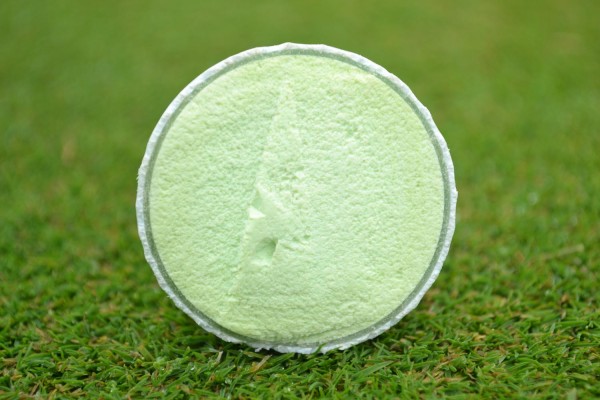 The Chrome Soft is all about the core, and since Callaway is devoting advertising space to actually talking about the compression of the golf ball, let’s dig into it a bit more.
The Chrome Soft is all about the core, and since Callaway is devoting advertising space to actually talking about the compression of the golf ball, let’s dig into it a bit more.
Thanks to a brand new SoftFast core, as Callaway calls it, the ball has a compression rating of 65. By comparison, last year’s Callaway SR-3 had a compression of around 105. Typically, the softer the core, the more the ball deforms at impact. This is great for slower swing speed players who need the ball to deform more so it can spring back into shape and generate more distance. But faster swing speed players can actually lose distance if the ball is too soft. After experimenting with 39 different prototypes, however, Callaway was able to create the right combination of the core and mantle layer so the Chrome Soft retains the energy from impact and keeps ball speed high — even at faster swing speeds.
The Chrome Soft is available now in White, Soft Yellow and Truvis Technology with an MSRP of $37.99. Custom player numbers and personalization is also available.
Performance
We put the new Chrome Soft to the test against the Callaway Speed Regime SR-3, which I tested last year.
Compared to the Speed Regime line the Chrome Soft should:
- Feel softer off every club, with slightly better durability.
- Generate less spin off the driver.
- Create more spin off shorter irons.
Like all reviews, I tested these on the range, on the course, and on a launch monitor with a 60-degree wedge, 6-iron and a driver. I headed to BridgeMill Golf Academy and worked with head pro Tom Losinger to get the data using a Trackman in his indoor studio.
60-degree full wedge shots
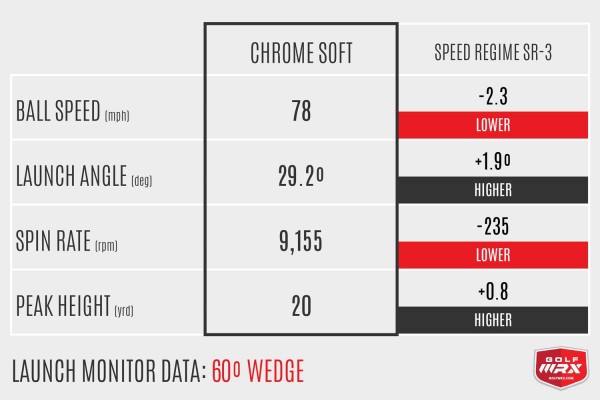
Main differences we expect to see: The Chrome Soft should generate more spin on full wedge shots.
What the data actually shows: Exactly what we expected to see. The Chrome Soft generated 200 rpm more spin than the SR-3, while launching lower and hitting a slightly lower peak height. I did, however, see a big difference in ball speed and carry distance, with the Chrome Soft flying three more yards on average.
Increased ball speed or carry distance with the shorter irons is not typically on the list of requests from better players. In this case, it’s a by-product of the new SoftFast core and three more yards of carry with a 60-degree wedge is fairly significant. That 10-foot putt for birdie is now almost 20. These types of gains will require an adjustment.
What I saw on the course: This ball was perfect inside 100 yards. If it was flying farther than other balls I’ve played, I didn’t notice. The trajectory on full wedge shots was nice and low compared to other balls, and I was already able to notice a difference in feel between the Chrome Soft and the SR-3. A difference of 200 rpm of spin wasn’t noticeable on the course, as both balls performed very similarly when they hit the green.
6-iron shots
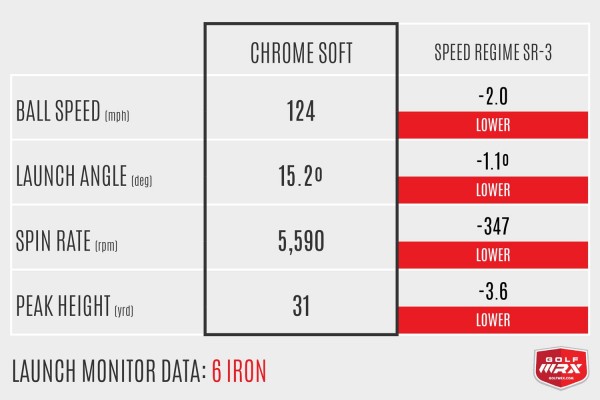
Main differences we expect to see: The Chrome Soft should generate faster ball speeds and less spin than the SR-3.
What the data actually shows: The data backed up the expectations when it came to ball speed. However, I actually saw more spin on my 6-iron compared to the SR-3 and even other tour balls. This could be due to a variety of factors concerning my individual swing, and other golfers might see less spin off their mid irons. Compared to the SR-3, the Chrome Soft launched a little higher, with more spin and ball speed, allowing it to carry a little more than one yard farther. It also hit a higher peak height with a steeper descent angle.
What I saw on the course: I was probably most impressed with the Chrome Soft with the mid to long irons. Yes, the ball performed great off the driver, but the softer feel was very apparent with an iron in my hands. Launching shots with mid to long irons had a more effortless feel. I was also able to get some nice height and spin on my longer irons without sacrificing distance, so I could land shots on the green and see them stick, instead of hitting and running off the back.
Driver shots
Main differences we expect to see: The Chrome Soft should spin less, but still generate more ball speed than the SR-3.
What the data actually shows: I’m a borderline high-speed guy with the driver. My average swing speed is around 106 mph — right on the borderline where golfers can start to “over-compress” the Chrome and possibly lose distance.
You may have read editor Zak Kozuchowski’s reviews on GolfWRX, who can generate more than 115 mph of swing speed with his driver. In his on-course testing, he said he hit the Chrome Soft about the same distance as other tour balls.
“If they liked everything else about the ball, I can’t imagine a golfer who swings 105+ mph wouldn’t play the Chrome Soft just because it was a few yards shorter than a higher-compression tour ball off the tee,” he said. “If a soft feel is important to them, that’s going to take precedence over a few yards of extra distance. And they’ll get those few yards back with their long irons, anyways.”
In my testing, the Chrome Soft generated slightly faster ball speeds, and a lot less spin — almost 300 rpm less spin than the SR-3. This translated into an extra 1.5 yards of carry, and more than 5 extra yards of total distance.
What I saw on the course: The distance gains and lower spin appeared to translate to the course. I wasn’t having any issues getting the ball to run out once it hit the fairway. And the distance appeared to be spot on, if not slightly longer.
Around the green
It is always fun to have that moment in a round where you hit the low, checking chip that freaks out your playing partners. I had that moment from about 55 yards away to a back pin, with out of bounds directly behind the green. With a 56-degree wedge, I hit the low shot and right before the ball hit the green, my playing partners were yelling “get down!” But I knew I hit it well and the ball bounced, checked, and then just lipped the cup.
Could I have executed that shot with other tour balls? Yes. But, it is important to know I can execute it with the Chrome Soft. I’m not a short-game wizard like one of Callaway’s more well-known tour pros, but these balls allow me to hit any kind of shot around the green without hesitation.
Putting
The Chrome Soft feels much softer than the SR-3, which was noticeably softer than previous generation Callaway tour balls. The sound profile has a lower, less “clicky” sound that translates into improved feel. The engineers really have brought the incredible feel of the SuperSoft to the tour-level Chrome Soft.
I’ve rolled some beautifully smooth putts with these balls. They are predictable and roll true when you strike them well. While I won’t go so far as to say they are the best feeling golf ball on the market (although they are close), they are the best feeling Callaway golf ball I’ve tested.
Durability
When most people hear “softer cover,” they instantly assume it will be less durable — and for good reason. It is counter intuitive to believe that soft equals durable. I’m not going to pretend to know the science behind it, but the DuraSpin cover is made from Thermoplastic Urethane, which actually becomes more durable the softer it gets.
I’ve played numerous rounds with the same ball, and also completed all the testing with only three Chrome Soft golf balls, so I can back up Callaway’s claims. These balls are definitely durable and can last numerous rounds if you don’t lose them. With fresh wedge grooves, I was getting all the spin benefits and little to no scuffing. I did see some minor scuffs after finding some rocky rough off the tee, but the ball was still playable and I shouldn’t have been over there in the first place!
The Takeaway
If you’ve avoided Callaway balls in the past because of the “clicky” stigma that has followed them around, it might be time to try a sleeve of the Chrome Soft. Many golfers, myself included, really love the feel of the Callaway SuperSoft, but not the overall performance. The Chrome Soft is a marriage of the soft feel of the SuperSoft with the tour-level performance of the Callaway SR-3. With low spin off the driver and the most spin on short irons of the tour balls I’ve tested this year, the Chrome Soft is one of the best golf balls on the market today.
We gave the Chrome Soft 5 stars, but one of our editors made the case that on a scale of 1-10, the Chrome Soft is an “11.” If you’ve seen the movie Spinal Tap, you know what he means.
See what GolfWRX Members had to say about the Chrome Soft in our Official Forum Testing Thread.
[wrx_retail_links productid=”12″]
- LIKE267
- LEGIT34
- WOW18
- LOL3
- IDHT5
- FLOP1
- OB2
- SHANK24
-

 Product Reviews1 week ago
Product Reviews1 week agoThree Swing Challenge: Testing the Edel Array F-2 putter
-

 Equipment1 week ago
Equipment1 week agoWhat clubs do equipment free agents choose to use on tour? We found out
-

 19th Hole3 weeks ago
19th Hole3 weeks ago‘You’re right, we’re always wrong!’ – Sergio Garcia receives warning during Open qualifier
-

 News2 weeks ago
News2 weeks agoHighlights from the Wilson Golf Product Testing and Fitting Experience at Pinehurst
-

 News2 weeks ago
News2 weeks agoDavis Thompson’s winning WITB: 2024 John Deere Classic
-

 Equipment3 weeks ago
Equipment3 weeks agoQ&A: The truth behind Bryson DeChambeau’s new Avoda irons from company founder Thomas Bailey
-

 19th Hole2 weeks ago
19th Hole2 weeks agoMajor champ ‘disappointed’ not to be chosen as U.S. Ryder Cup captain
-

 Whats in the Bag3 weeks ago
Whats in the Bag3 weeks agoCam Davis’ winning WITB: 2024 Rocket Mortgage Classic

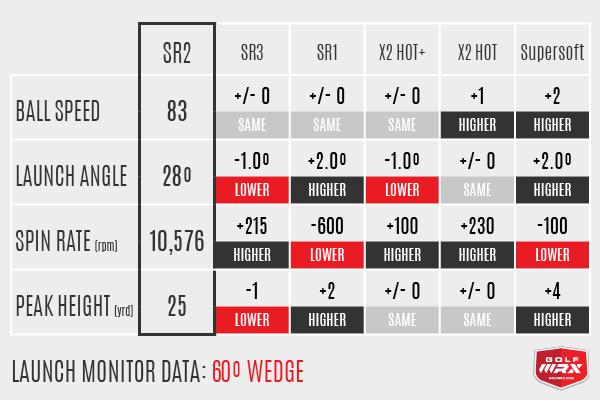
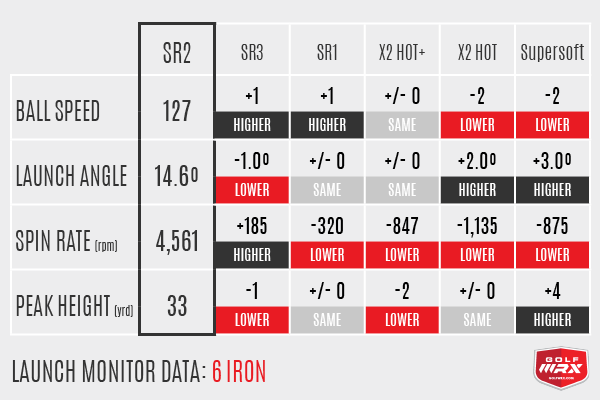
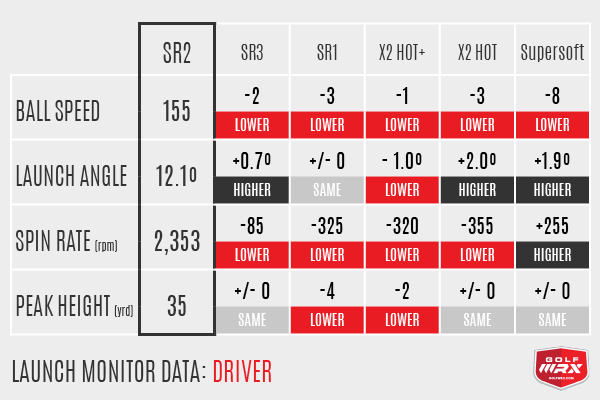
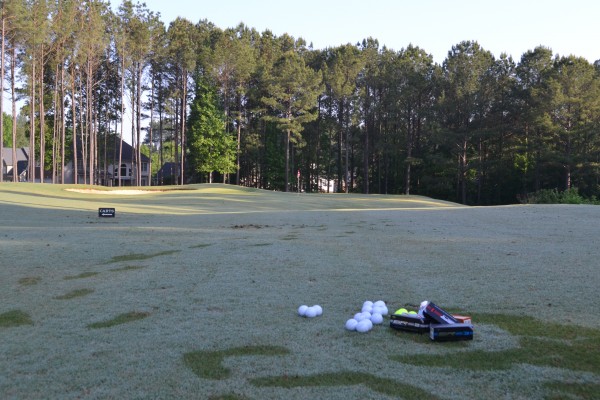
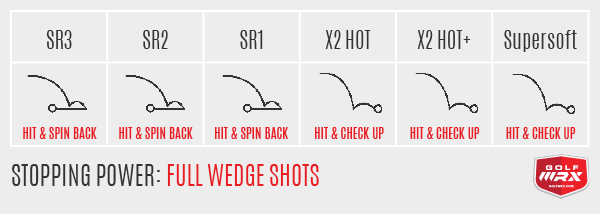
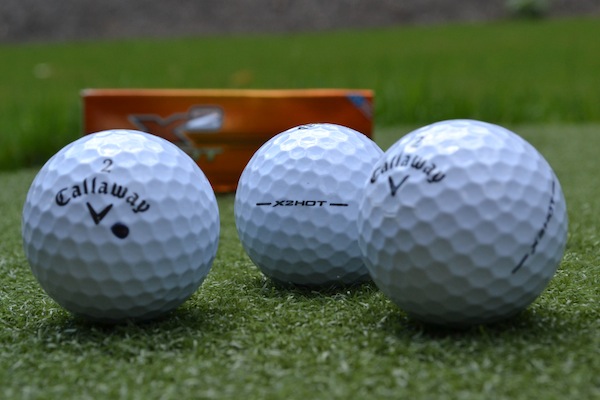
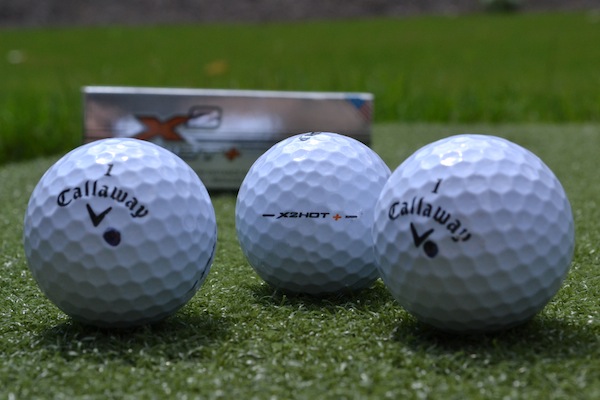
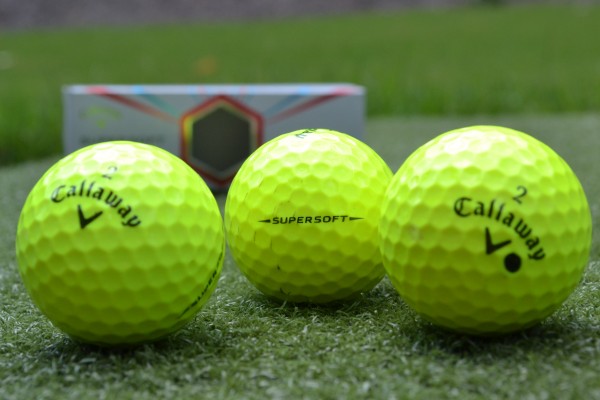


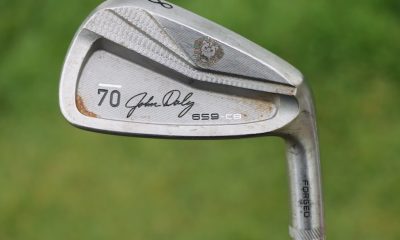

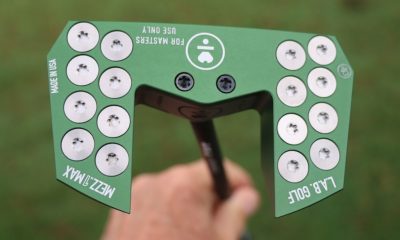

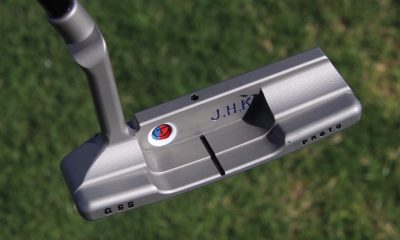







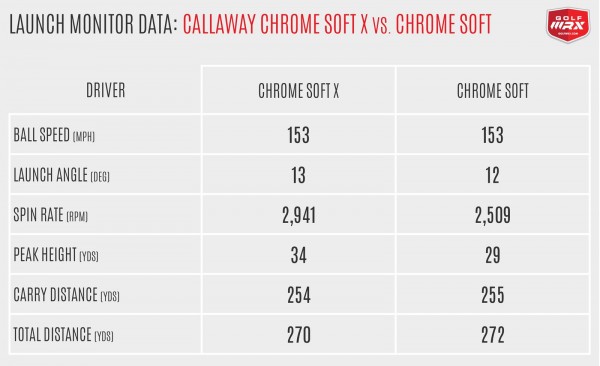
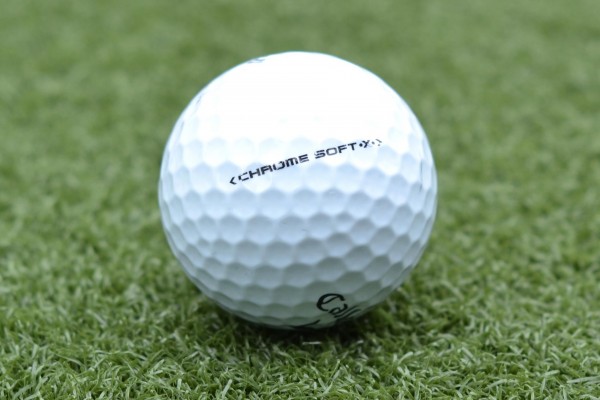
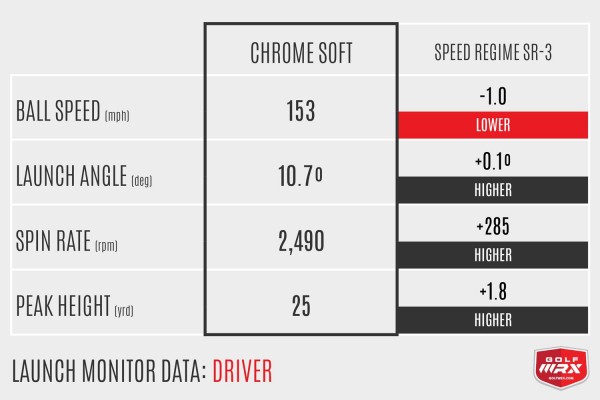
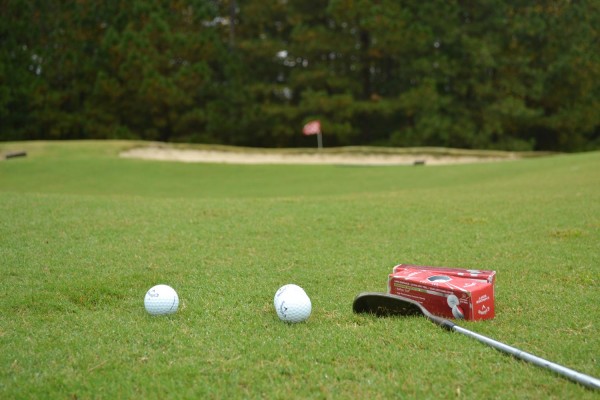
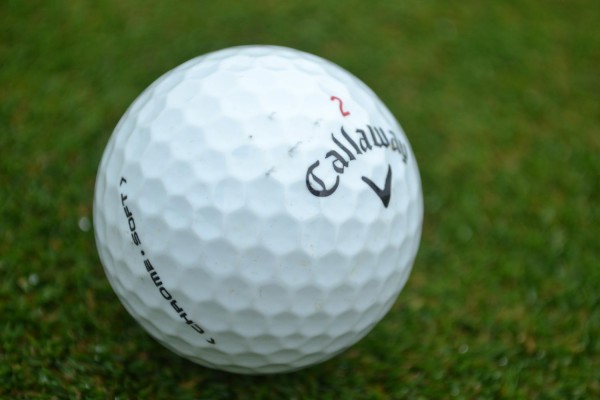
















Mike Cleland
Nov 7, 2016 at 11:00 pm
Real good ball. Longer off the tee with m2 driver. Good around & soft but solid on the greens. Ball goes very straight. I did crack one, which really surprised me. I am a 3 handicap, 67 years old & have an under 100 swing speed. I don’t care about the price, but feel it’s a better ball than the ProV1 I was using.
sven johannson
Jan 3, 2015 at 11:52 pm
Love The Supersoft Ball not only for slower swing speeds it does launch higher and longer for me around 95 mph swing speed. looking forward to trying the Chrome Soft until then count me as a Supersoft fan.. feels great on and around the green !!!
Harris
Dec 3, 2014 at 9:48 pm
I play of a 4HC and I have to say that this ball performs great and is not going to hurt your game in any way. But there are 2 significant things that stopped me from playing another round with. First it is the sound this ball makes when stuck with an iron, it just doesn’t sound right. Second the feedback you get when hitting a shot, it just feels like a dead duck in the water especially with your shorter irons.
Pingback: X2 Hot Is Our Longest
JOEL GOODMAN
Jul 9, 2014 at 2:45 pm
I BELIEVE 90%+ OF ALL GOLFERS COULD NOT TELL THE DIFFERENCE IN BALLS IF THEY ALL WERE LABELLED XXX. MOST PLAYERS CAN’T HIT THE SAME SHOT TWICE IN A ROW WITH THE SAME CLUB. THE BIGGEST DIFFERENCE IN GOLF BALLS IS THE ADVERTISING AND THE PRICE. I PLAY TO 5 INDEX AND CAN HIT THE EXACT SAME SHOTS AND STOP “ANY” BALL ON THE GREEN WITH THE PROPER SWING AND STRIKE. ADVICE TO MOST GOLFERS—BUY WHAT’S ON SALE, YOU’LL NEVER KNOW THE DIFFERENCE AND YOU HIT HALF OF THEM IN THE WATER ANYWAY.
Harris
Dec 3, 2014 at 9:50 pm
What’s a 5 index or do you only play index 5 holes?
Hellstorm
Jul 5, 2014 at 8:14 pm
Good review….I don’t think I have ever actually purchased a Callaway ball but if I am in the market for a distance ball, I might give the + a try.
Pingback: Review: Callaway X2 Hot, X2 Hot+ and Supersoft Golf Balls | Spacetimeandi.com
Greg
Jul 3, 2014 at 6:23 pm
Great review but it would have been wonderful to see someone with a bit lower swing speed test the hot and super soft. Super soft seems to be a winner for average and low ss golfers at that price.